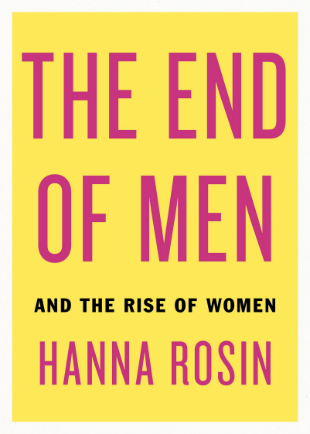The End of Men by: Hanna Rosin
340 pp.: Viking, 2012
Reviewed by Kathryn Marshall
Hanna Rosin’s The End of Men is not a book you’ll find on a women’s studies course reading list. That’s a shame, because it offers a strikingly different take to gender issues than what we’re used to.
Rosin’s general thesis is that a once male-dominated world has, in only a few generations, become a place where women are leading the way in the classroom, boardroom and family room, and this trend will continue into the future because women are better equipped to be flexible with the times.
When I completed my degree in women’s studies and feminist research in 2008, the glass ceiling and “patriarchal systems” of oppression were the dominant themes. We read more than our fair share of gender-themed books, most of them from the 70s and 80s. This was appropriate since that was the era many women’s studies departments seem to be stuck in.
In my lectures I was often told my gender was oppressed by a male-dominated world. This seemed out of step with reality. I certainly didn’t feel that way. Like many of my friends, I was busy making career plans and exploring exciting options for the future, not bemoaning patriarchy or the heavy weight of a double-paned glass ceiling over my head.
Rosin’s book would have been a welcome change in class because it describes society as it is now, not the way it was forty years ago. Rosin’s book is geared for a new generation of women making waves in the female-empowered society our mothers fought hard for us to have.
Compare today’s world to a scene out of the popular drama “Mad Men” set in the 1960’s. The old rules have been turned upside down and it’s a whole new world. It’s this new world that Rosin describes.
According to Rosin, we now live in a world where women aren’t just on par with men, but are far exceeding them in many areas of life. Using statistics to back up her thesis, Rosin shows that women now earn almost 60 percent of all bachelor’s and master’s degrees, earn more PhDs than men, hold the majority of America’s jobs, and are dominating in professions like health and law. Women are entering traditionally male dominated fields like engineering, business and science in increasing numbers too.
And men? According to Rosin, they aren’t excelling in our rapidly changing world quite as well as the women. She argues that while the role of women has evolved dramatically, the role of men in society has remained largely static.
Rosin goes into detail explaining how there are plenty of examples of jobs that have seen a switch from all-male to female, but very few all-female to male. Think about it – female lawyers are now commonplace, but a male nurse is still often still the punch-line on TV.
According to Rosin, economic changes are more likely to impact men as a gender than women. She refers to it as the “mancession” – where the recent economic downturn in the US threw many more men out of work than women.
Contrary to what this book’s needlessly provocative title suggests this is not an apocalyptic tale about the end of men. Rather, The End of Men is really about evolving gender roles and how these changes have impacted practically every aspect of life, and will continue to do so.
Rosin weaves together a somewhat disjointed narrative of statistics, history, anecdotes and interviews and presents a persuasive case that changes in the political, social and economic landscape have catapulted women ahead.
We’ve read headlines and heard talks of this trend for years, but Rosin manages to capture a comprehensive snapshot of what the “rise of women” looks like right now – culturally, economically and socially – across different cultures and socio-economic classes. That said, one major criticism is that the book is too heavily centered on the middle and upper-middle classes. This is a particular weak point as it is the lowest income groups that have been hit the hardest in the last few years.
Rosin conducted interviews with men and women from a variety of backgrounds, exploring three main themes: sex, family and career.
The sex lives of young single female Ivy-League students features prominently in Rosin’s book. She argues women have a newfound power and control in their sexual liberation where they are free to date and “hook up” without the pressure of being saddled down in a committed, time-consuming relationship. This is a neither new nor original observation, and is better dealt with in fiction rather than the awkwardly voyeuristic exercise of an academic discussing undergraduate sex in a salaciously clinical manner.
What’s really changing society is not so-called transient sex lives, but that women are staying single longer, focussing more on building their careers and getting educations, thus delaying marriage and starting families.
The hero in Rosin’s book seems to be a woman in her late twenties or early thirties with no kids. Sixty years ago, a woman fitting that description would have already been married for ten years and would probably be viewed by society with sympathy for her childless status. Today, with her MBA or law degree in hand, tailored suit, and lack of social pressure to wed and immediately have kids, her possibilities are endless.
The norm used to be that a woman worked until she was married, or then maybe worked part-time or went back to work once the kids were grown. Today women are focussed on their careers and excelling in school and in their jobs.
Rosin also explores in detail the shifting roles in family life that are happening. Today, there are more stay-at-home dads than ever before and more females who are the primary income earner. Rosin describes how gender roles are becoming more fluid and interchangeable, and households have more equality in the sharing of domestic duties.
Ultimately, the point of the book is that the goal of equality championed by the feminist movement hasn’t just been achieved, it’s been greatly surpassed.
It’s no wonder that with a message like this some of Rosins biggest critics have been feminists. If they accepted her conclusions, many of those women’s studies departments would be out of business.
But is Rosin overstating the case that women’s equality has come so far that women have now pulled ahead of men?
Rosin deals with the fact that women still have not achieved full equality in the upper echelons of power. Try to tally the number of female CEO’s, law partners and political leaders out there and the final number does not remotely reflect the stunning numbers of female university undergraduates.
Better yet, read some of the coverage that came out of Yahoo CEO Marrisa Mayer’s announcement that she was pregnant. A male CEO announcing he was about to become a father would not have generated even a splash of ink.
What about family and gender roles and how much have these evolved? While she did many interviews, Rosin states “I did not talk to a single breadwinner wife who has entirely ceded the domestic space.”
Interesting questions that could have been explored more in this book are why are there so many women graduating from law school, but still so few female partners in law firms, and why are stay at home dads still a relatively rare occurrence?
Ultimately, Rosin’s title is simply too presumptuous, and her thesis too premature. She has written about one of the biggest shifts in human society since the discovery of agriculture, but has assumed it has been completed in only 40 years. There is a lot more of this ride yet.
~
Kathryn Marshall is a columnist, political commentator and an articling student at a litigation firm in Vancouver. Her column “The Duel” appears weekly in 24 Hours Vancouver where she debates the issues of the day.
Kathryn’s columns and op-eds on law, politics and public policy have appeared in print and online in more than a dozen newspapers and magazines across Canada. She blogs at the Huffington Post Canada, internationally at Reuter’s TrustLaw and at kathrynmarshall.ca. She is a frequent guest on talk radio and television, including regular appearances on CTV’s Political Express panel. Her advocacy work have received extensive coverage in the media, including Maclean’s Magazine, The Economist and Global National news.
Originally from London Ontario, Kathryn holds an Honours B.A. in Women’s Studies and Political Science from Western University and a J.D. from the University of Calgary, where she served as an Editor of the Faculty of Law student newspaper.
Kathryn volunteers her time with several community organizations, including the Make-A-Wish Foundation of British Columbia and Yukon.





